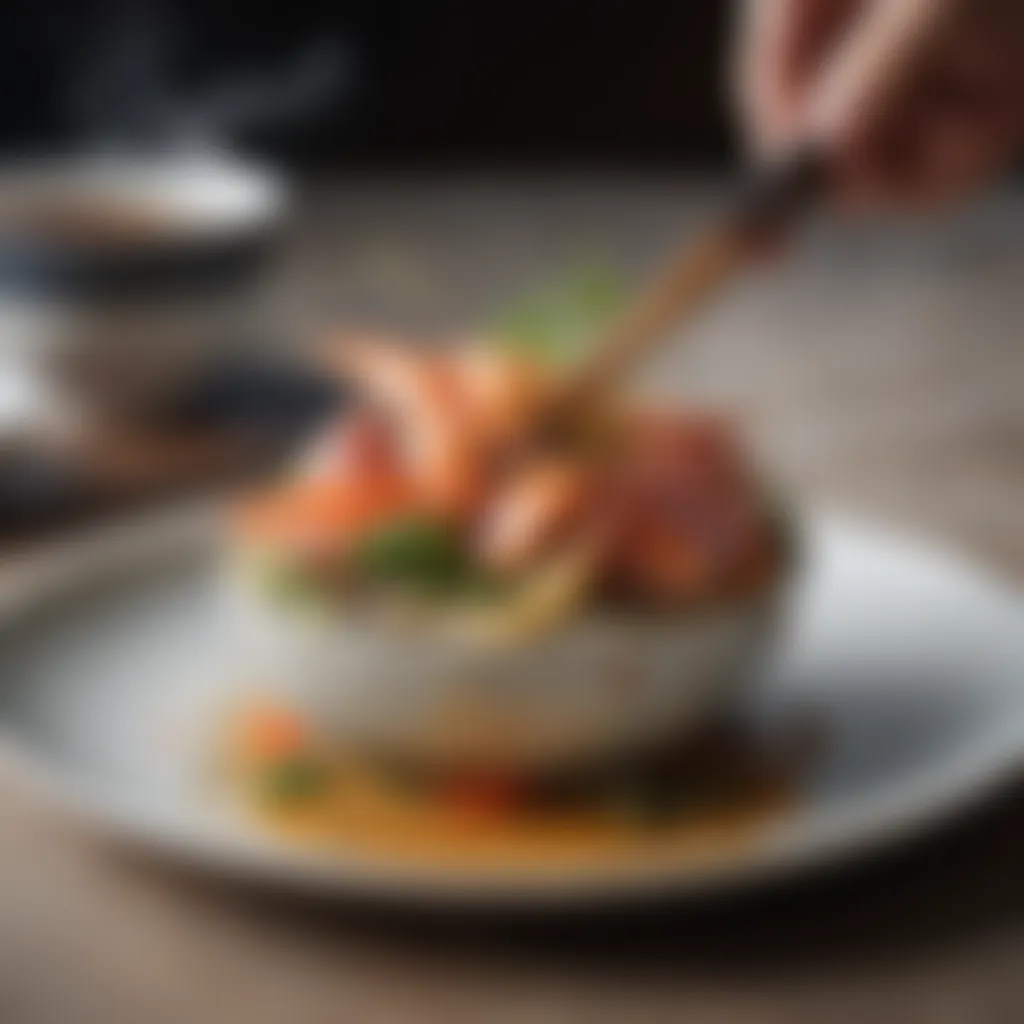Discovering the Kitsuzeo Recipe: A Culinary Journey


Intro
In the world of culinary arts, few dishes command the respect and admiration that Kitsuzeo does. This unique recipe is not merely a meal, but an exploration into tradition, culture, and a showcase of delicate skills. Kitsuzeo has deep roots, often characterized by its intricate preparation and authentic ingredients that speak to the heart of those who’ve tasted it.
As we embark on this culinary journey, we’ll delve into each element that makes Kitsuzeo an art form, guiding you from the selection of ingredients to the final tasting. This is done not just for the seasoned chefs but also for those who find joy in cooking at home.
Ingredients:
To make a traditional Kitsuzeo, you need to gather the following ingredients:
- 500 grams of fresh fish (such as salmon or tuna)
- 200 grams of soy sauce
- 100 milliliters of sake
- 50 grams of mirin
- 20 grams of sugar
- 2 cloves of garlic, minced
- 1-inch piece of ginger, finely grated
- 1 tablespoon of sesame oil
- Fresh herbs for garnish (like cilantro or green onions)
It’s crucial to use fresh, high-quality ingredients. This recipe thrives on the vibrancy of the fish and the combined flavors from the marinade. Any replacements or substitutions may affect the final taste significantly.
Preparation Steps:
The preparation of Kitsuzeo is as important as the cooking. Follow these steps carefully:
- Prepare the Marinade: In a mixing bowl, combine the soy sauce, sake, mirin, sugar, minced garlic, and grated ginger. Stir well until the sugar dissolves completely.
- Marinate the Fish: Cut the fresh fish into fillets and place them in a shallow dish. Pour the marinade over the fish, ensuring it’s well-coated. Cover this and let it sit in the refrigerator for at least 1 hour, though overnight is best for deeper flavor.
- Preheat Your Cooking Surface: Before you start cooking, preheat your pan or grill over medium heat. You want to ensure it’s hot enough to give a nice sear but not so hot that it will burn the marinade.
Technical Aspects:
Understanding the technicalities behind the cooking process is essential for achieving superb results:
- Temperature Settings: Maintain medium heat while cooking. Too high heat can lead to uneven cooking or burned sauce.
- Timing Specifics: Cook the fish for about 4-5 minutes on each side. This timing can vary slightly based on the thickness of the fillets, but the fish should be opaque throughout.
- Critical Techniques: Make sure to sear the fish without moving it too much in the pan initially. This allows a nice crust to form, giving texture to every bite.
Cooking Process:
Now, let’s take you through the sequential steps:
- Sear the Fish: After marinating, remove the fish and let any excess marinade drip off. Place the fillets in the hot pan. Sear without moving them for about 4-5 minutes.
- Flip with Care: Use a spatula to gently flip the fish. This is the key moment; the crust should be golden brown. Cook the other side for another 4-5 minutes.
- Add Sesame Oil: Just before the fish is done, drizzle a bit of sesame oil over the fillets for a final flavor boost.
- Garnish and Serve: Once cooked, garnish with your choice of fresh herbs. This adds freshness and a burst of color to the dish.
Troubleshooting Tips:
Even the most seasoned cooks can hit a snag. Here are some common mistakes and adjustments:
- Fish Is Sticking: Ensure your cooking surface is adequately heated and the fish dry from excess marinade before adding to the pan.
- Too Salty: If the dish comes out saltier than desired, serve it with a side of plain rice to balance the flavors.
- Undercooked Fish: Use a thin knife to check doneness; the fish should easily flake apart when cooked correctly.
Cooking Kitsuzeo is both intricate and enjoyable. With each step, you’re not just preparing a meal; you’re creating something special that can be shared and savored.
With these steps, tips, and ingredients, you are well on your way to mastering Kitsuzeo. Happy cooking!
Preface to Kitsuzeo
The world of culinary arts is rich with traditions, flavors, and techniques that travel through generations, and one such gem is Kitsuzeo. This particular dish isn't just another recipe tucked away in a cookbook; it represents a tapestry of history, culture, and sheer creativity in the kitchen. Understanding Kitsuzeo is important if we want to appreciate the depths of its flavors and the story it tells. It’s not merely about cooking; it’s about an experience that bridges the past with the present.
Diving into the essence of Kitsuzeo provides insight into its core components and preparation methods. By exploring this dish, one can discover the authentic ingredients that take precedence in its making, alongside the meticulous techniques that elevate it into a culinary art form. The appreciation of Kitsuzeo solidifies a home cook's skills, turning an ordinary meal into extraordinary storytelling.
Historical Background
The roots of Kitsuzeo extend backward in time, influenced by diverse culinary practices from various cultures. Initially, it may appear as just a recipe, but its historical context reveals layers of significance. This dish emerged during a period when cooks were trying to integrate what was available locally with inspirations drawn from travel and trade. Ingredients like fresh vegetables, proteins, and spices take center stage, shaped by the seasons and regional availability.
Traditionally, Kitsuzeo was prepared in homes as a celebration of abundance and sharing among families. Each family might have had unique spins on how this dish came together, leading to a delightful variety that still exists today. Moreover, the transformation of Kitsuzeo over the years reflects societal changes—new ingredients introduced, cooking styles evolved, and tastes refined. It's fascinating to see how this dish serves as a culinary timeline, representing eras gone by.
Cultural Significance
The cultural backdrop of Kitsuzeo cannot be overlooked. When one prepares this dish, they’re partaking in a ceremony of sorts—one that pays homage not just to flavor, but to heritage and community. For many cultures, food represents more than just sustenance; it conveys identity, values, and connections between people.
In numerous regions where Kitsuzeo is revered, the act of preparing and enjoying this dish often invokes family gatherings, celebrations, and even solemn occasions. It's the dish on the table during festivities, symbolizing togetherness and continuity. The unique blend of flavors in Kitsuzeo appeals not only to the palate but also resonates on an emotional level, enhancing relationships among family and friends.
To sum it up, the importance of Kitsuzeo stretches beyond the kitchen. It encapsulates a rich history that is worth exploring, as well as cultural narratives that enrich the cooking experience. Understanding Kitsuzeo invites culinary enthusiasts, whether novice or seasoned, to delve deeper into the art and craft of cooking, making each meal an occasion worth celebrating.
Understanding the Essentials of Kitsuzeo
Understanding the key elements of Kitsuzeo is paramount for anyone serious about mastering this artful dish. Diving into its essence provides a solid foundation for preparation that is both authentic and engaging. This section focuses on the ingredients and tools necessary, offering insightful perspectives that can greatly enhance one’s culinary journey.
These essentials not only lay the groundwork but also enrich the cooking experience by highlighting the most practical and effective ways to approach the recipe. It’s about turning what may seem like a simple meal into a culinary masterpiece, preparing one to tackle various challenges that arise in the kitchen.
Key Ingredients
Main Components


The main components of Kitsuzeo are what give the dish its unique flavor and texture. This typically consists of tender cuts of meat, fresh vegetables, and a rich broth that simmers to perfection. The rich umami flavor from the ingredients enhances the overall taste.
One standout aspect is the choice of protein. Typically, it's best to go for high-quality cuts, such as ribeye for beef or fresh chicken thighs, precisely because these options provide moisture and depth to the dish. The result is a dish that's not only delicious but also soul-satisfying.
Quality Considerations
Quality ingredients can make or break any culinary effort. In the realm of Kitsuzeo, using premium ingredients affects the final outcome significantly. Select vegetables that are vibrant and firm; they should still have a bit of crunch to them. This elevates not just the flavor but also the overall aesthetic of the dish.
What stands out here is the direct link between quality and health benefits. Fresh, organic ingredients not only taste better but also pack more nutrients. This means that while enjoying Kitsuzeo, you're not just indulging your taste buds but also nourishing your body.
Seasonal Variations
Adapting the recipe to the seasons can significantly impact flavor and enjoyment. In summer, you might find tomatoes and cucumbers shining in the foreground, adding freshness, while in fall, root vegetables and hearty greens take center stage.
Employing seasonal ingredients fosters creativity as well. For example, a winter Kitsuzeo might include sweet squash or kale, transforming the dish into something entirely different that reflects its time of year. Thus, this not only broadens your culinary repertoire but allows for sustainable cooking practices as you rely on what’s available.
Necessary Tools and Equipment
Traditional Utensils
Traditional utensils play a vital role in the cooking of Kitsuzeo. Items such as a heavy cast-iron pot or a wooden spoon are not just nostalgic; they serve practical purposes as well. A cast-iron pot distributes heat evenly, preventing any scorching and ensuring that flavors meld beautifully together.
It’s also about the experience – the tactile sensation of well-made tools gives a sense of comfort and familiarity. They help in creating an ambiance that resonates with the traditional roots of the dish, allowing the cook to further connect with their culinary heritage.
Modern Alternatives
While tradition carries weight, modern alternatives can streamline the cooking process. For instance, using a slow cooker or an Instant Pot can save precious time for home cooks managing busy lives. The convenience of these devices adds a layer of adaptability that can be very appealing.
However, it’s crucial not to overlook the significance of traditional techniques while using modern tools. The goal should be an enjoyable experience with consistent, flavorful results. For creating a reliable and robust Kitsuzeo, exploring both traditional and contemporary tools offers the best of both worlds.
Step-by-Step Methods for Preparation
The journey to mastering Kitsuzeo isn’t just about flashy cooking techniques or over-the-top ingredients; it’s about getting your hands dirty with the nitty-gritty elements of preparation. This section lays down the framework for how to approach the cooking process meticulously. Each step is significant and cannot be skipped.
Not only do proper methods enhance the flavors and textures of the dish, but they also imbue the culinary practice with respect—honoring tradition while fostering innovation. Whether you’re a seasoned cook or a curious novice, understanding these methods will be your compass to navigate the kitchen effectively.
Preparing the Ingredients
When it comes to Kitsuzeo, the preparations of the ingredients can truly make or break the dish. There’s an old saying, “A chain is only as strong as its weakest link,” and the same goes for cooking. The groundwork established during this phase secures your dish’s success.
Washing and Cutting Techniques
Washing and cutting aren’t just mundane tasks—they are a critical part of ingredient preparation. It’s here that ingredients shed their rawness and transform into a culinary canvas. The key characteristic of effective washing is that it ensures that dirt and contaminants are removed. Tapping into fresh ingredients takes you a step closer to the finished flavor profile.
Why is this important?
Using proper washing techniques decreases the risk of unwanted flavors, which can compromise your meal even before it hits the stove. For instance, leafy greens or herbs are particularly susceptible to residual pesticides or grit.
A unique aspect of cutting techniques is the knife skills involved. Using precise cuts promotes even cooking, allowing flavors to meld beautifully. Plus, shaping ingredients stylishly could enhance the presentation down the line—every chef appreciates visually appealing dishes.
Yet, if these techniques are done hastily, you might end up with uneven sizes, throwing off cooking times and dousing your dish in disappointment.
Marination Process
Next on the list is the marination process, a crucial step that infuses flavor deep into the ingredients. The essence of marination lies in its capacity to tenderize meats and enhance flavor, a method revered in many culinary traditions.
By soaking the ingredients, you allow a rich tapestry of tastes to seep in, significantly elevating the dish. A classic blend of soy sauce, garlic, and a touch of ginger simplifies the process while laying a strong foundation for the Kitsuzeo flavors.
Why choose marination?
Marination is popular not just for flavor but also for the way it softens proteins. The acids or enzymatic elements often present in marinades help to break down tough fibers, which can make your dish taste heavenly.
What’s unique about marination is the timing. Short marinations might yield decent flavors, while longer ones may provide umami-packed goodness that practically dances on your palate. However, marinating for too long can turn textures mushy— striking a balance is paramount.
Cooking Techniques
Once our ingredients are prepped, it’s time to delve into cooking. The methods we select will determine the essence of our Kitsuzeo dish. This phase allows control over the final results by adjusting factors like heat and timing.
Cooking Methods Overview
Understanding different cooking methods is key to unlocking culinary skills. Kitsuzeo can be prepared through grilling, braising, or simmering, each contributing a distinct quality to the dish.
Using variations in cooking methods introduces different textures and flavor layers, making the dish exciting each time.
Why is exploring methods beneficial?
Familiarizing yourself with multiple methods empowers you to adapt recipes according to ingredient availability or kitchen tools.


Notably, grilling might impart a smoky flavor, while simmering could yield a more delicate outcome. However, if not done carefully, you might end up burning or overcooking delicate elements in your dish, which is a common pitfall to avoid.
Temperature Control
Temperature control is a prominent factor in cooking anything, but especially in Kitsuzeo preparation. The cooking temperature defines how ingredients will react and contribute to the final dish.
Why is controlling temperature essential?
Every ingredient has its optimal cooking range, and going too high or low can spoil the texture and taste. Maintaining consistent temperature ensures proper cooking, enabling flavors to blossom without scorching.
The unique feature of temperature control in Kitsuzeo is the dual approach— simmering some elements while searing others. If you let your attention wane, you risk launched flavor profiles flying right out the window.
Timing for Optimal Results
Finally, we have timing, perhaps the most elusive yet crucial aspect of cooking Kitsuzeo. The right amount of time spent cooking each component can enhance or degrade the dish entirely.
Why is timing integral?
Precision in timing aids in achieving that perfect doneness, ensuring every bite is satisfying. You wouldn’t serve a great piece of meat that's either undercooked or burnt, would you?
A unique aspect of timing in Kitsuzeo lies in the synergy it creates amongst elements. Coordinating different components allows for balanced flavors in each framing bite. Mistakes here can lead to textures clashing rather than harmonizing, ultimately disrupting the culinary composition.
"Success in the kitchen is not just about following the recipe; it's about creating a symphony of flavors through careful preparation and timing."
Thus, each step is a stepping stone to bringing your Kitsuzeo to fruition. Meticulous preparation, methodical cooking, and tactical timing are all building blocks of culinary excellence.
Elevating Kitsuzeo Through Presentation
Presentation is a crucial aspect of the culinary arts, and when it comes to Kitsuzeo, it transcends mere aesthetics. The way a dish is presented can transform the dining experience, enhancing not just the visual appeal but also influencing the perception of taste. A beautifully plated Kitsuzeo can evoke emotions and anticipation, setting the stage for a memorable meal.
The focus on presentation emphasizes that cooking is not only about combining ingredients but also about creating an experience. By paying attention to details, cooks convey care and artistry, which can captivate guests from the moment they set eyes on the dish. Consider this: when we eat with our eyes, we often eat with greater enjoyment.
Plating Techniques
Strategic Arrangement
Strategic arrangement is about more than just placement; it's creating a balance on the plate. When arranging Kitsuzeo, one must think about flow and how the eye moves across the dish. This technique contributes significantly to the overall experience by guiding diners into the flavors they are about to enjoy.
A key characteristic of strategic arrangement is asymmetry, which can be quite appealing. Instead of simply centering the main component, placing it slightly off-center can create visual interest that draws people in.
For example, if a Kitsuzeo dish features grilled fish atop a vibrant bed of vegetables, positioning the fish at a slight angle while artistically scattering some vegetables around it can elevate the presentation dramatically. The unique feature of this arrangement lies in its ability to tell a story. However, rushed placements can lead to a cluttered look.
Color Incorporation
Color incorporation is an exciting aspect of presentation. Using a palette of vibrant ingredients can make a dish irresistibly inviting. In Kitsuzeo, the interplay of colors from different vegetables, sauces, and garnishes enhances the visual dynamics.
Imagine a Kitsuzeo that includes bright saffron-hued rice, drizzled with a rich, dark sauce, and scattered with fresh herbs. The contrast creates a feast for the eyes.
This method is beneficial since well-balanced color combinations can evoke freshness and appeal. Unique features such as contrasting colors can enhance perception, making flavors seem more vivid. While this method is generally advantageous, overdoing colors can create a chaotic appearance, so moderation is essential.
Enhancing with Garnishes
Choosing Appropriate Garnishes
Choosing appropriate garnishes is not just about decoration; it's a way to enhance the dish's flavor profile. In Kitsuzeo, garnishes can provide additional textures and tastes, supporting or contrasting with the main flavors in the dish.
A main feature of selecting the right garnish is ensuring it complements rather than overwhelms the dish. For instance, sprigs of fresh cilantro or slices of lime can add zest and brightness, elevating the overall experience. This thoughtful touch connects diners to the essence of the meal.
Unique features of this decorative approach lie in enhancing both taste and appearance. Appropriate garnishes can make a dish feel complete while offering a sense of sophistication. However, poorly chosen garnishes may confuse taste sensations or detract from the intended flavors of Kitsuzeo.
Layering Flavors
Layering flavors takes both expertise and creativity. This approach refers to the idea of incorporating multiple complementary flavors in a dish, achieving a symphony of taste that captivates the palate. In relation to Kitsuzeo, layering is crucial in creating depth and interest.
A key feature of this technique lies in the sequential addition of ingredients. For example, starting with a base of umami-rich broth, followed by the protein, and finishing with delicate herbal notes, creates a multi-dimensional flavor experience. Such a method can be a popular choice for its ability to surprise the diner pleasantly with each bite.
This unique aspect encourages exploration of flavors and allows the dish to evolve as one savors each bite. Nevertheless, a misstep in pairing components can lead to clash; thus, careful consideration is essential in achieving harmony.
Ultimately, the art of presentation not only showcases culinary skill but also elevates the entire dining experience, inviting appreciation for the craft that is Kitsuzeo.
Common Variations of Kitsuzeo
Understanding the common variations of Kitsuzeo is vital for both chefs and enthusiasts alike. It reveals not only the flexible nature of the dish but also highlights how local cultures impact culinary traditions. Variations often stem from the ingredients available within different regions or even influence from neighboring cuisines. This section serves to appreciate this rich tapestry where each variation enhances the original recipe, making it approachable for a wider audience.
Regional Adaptations


Differences Across Regions
When it comes to the differences across regions, one cannot overlook how geography plays a key role. Each region tends to incorporate local ingredients, leading to distinct flavors and textures. For example, let's say you’re in the southeast of Asia, where palm sugar might find its way into the dish, giving it a sweetness that differs greatly from a version made in northern climates that uses honey. This type of substitution characterizes Kitsuzeo’s adaptability, transforming it into a dish that reflects its surroundings.
The delightful surprise of trying Kitsuzeo made with local flora or fauna adds not just flavor but also a layer of cultural context. It's no wonder why this approach is popular among food lovers.
Case Studies of Famous Variations
In the realm of case studies of famous variations, one can study particular adaptations that caught the culinary world by storm. Take, for instance, the Tokyo-style Kitsuzeo. It's celebrated for its emphasis on seasonal ingredients; chefs in this bustling metropolis often focus on simplicity, bringing out the best from fewer, high-quality components.
This specific style underscores a philosophy—less is more—widely embraced in Japanese cuisine. The main takeaway is that each region provides a unique approach, which not only diversifies the taste but also fosters conversation and exploration among cooks.
Innovative Twists
The evolution of Kitsuzeo doesn’t solely rest on regional adaptions; it also flourishes through innovative twists. Whether it’s blending international flavors or experimenting with conventional techniques, these creative approaches breathe new life into traditional dishes.
Fusion Concepts
Fusion concepts allow for an exciting juxtaposition of flavors and methods. Imagine a Mexican-Kitsuzeo fusion that incorporates chipotle or tomatillo, adding heat and acidity to an otherwise sweet dish. This melding introduces layers of flavors, creating a textural dance that captures the imagination.
Food lovers often appreciate these inventive ideas because they offer new ways to experience an old favorite. It’s that spirit of innovation that keeps culinary arts vibrant and relevant.
Contemporary Approaches
Finally, stepping into contemporary approaches, many chefs are now turning to plant-based alternatives. Think of making Kitsuzeo with cashew cream instead of dairy or spiralized vegetables instead of traditional pasta. Such changes cater to dietary restrictions while keeping the dish intact regarding flavor and presentation.
These modern interpretations make Kitsuzeo appealing, especially to the health-conscious crowd. However, it does pose questions about authenticity and the essence of the original dish. But as culinary traditions evolve, so too does the notion of what Kitsuzeo can mean today.
Nutritional Aspects of Kitsuzeo
When delving into the world of Kitsuzeo, it becomes paramount to explore its nutritional dimensions. The appeal of this dish goes beyond its enticing flavors to embrace elements that enhance our wellbeing. Understanding the caloric content and the health benefits of Kitsuzeo can help home cooks and culinary enthusiasts appreciate the dish not just for its taste but also for its contributions to a balanced diet.
Caloric Breakdown
Unpacking the caloric value of Kitsuzeo plays a crucial role in dietary planning. Generally speaking, traditional versions of this dish hover around 400 to 600 calories per serving, depending on the ingredients and portion size.
This caloric range is relatively moderate when one considers the richness of flavors and the satisfaction it offers. Ingredients like lean meats, fresh vegetables, and various spices contribute protein and essential nutrients without ballooning the calorie count too high.
Moreover, understanding this breakdown enables people who are monitoring their intake—like those on a weight-loss journey—to indulge without the guilt. If you replace higher-calorie components with lighter alternatives, such as using zucchini noodles instead of pasta, you can keep the dish light and vibrant without sacrificing flavor.
Health Benefits
Richness in Nutrients
Kitsuzeo stands tall when it comes to nutritional density. Among its many ingredients, you'll find that they offer a variety of vitamins and minerals such as vitamin C from bell peppers, fiber from vegetables, and antioxidants from spices. Why is this important? The variety ensures a broad spectrum of nutrients, making the dish a well-rounded addition to any meal plan.
One striking feature of the richness in nutrients is its ability to satisfy both hunger and nutritional demands. Rather than empty calories, every bite brims with potential benefits for one's overall health. Home cooks might take pride in knowing that they are serving a dish that's not only scrumptious but also contributes positively to their family's wellbeing.
Potential Dietary Considerations
While Kitsuzeo is chock-full of nutritional benefits, it is important to recognize that it can pose challenges for certain dietary restrictions. For instance, many recipes include soy sauce, which may not sit well with those who are gluten-sensitive or maintaining a low-sodium diet. Additionally, dishes rich in protein may require careful moderation for individuals managing cholesterol levels.
However, there lies a unique advantage in this dish's versatility. Cooks can easily customize kitsuzeo to fit various dietary needs by opting for gluten-free alternatives or reducing sodium levels without significantly compromising its integrity. This adaptability makes Kitsuzeo an endearing dish, as it can cater to a myriad of health-conscious diners while still offering that comforting, familiar taste.
The End and Reflections
In concluding this exploration of Kitsuzeo, one finds that the dish is more than just a recipe; it is a journey through culture, history, and culinary finesse. Understanding the layers behind Kitsuzeo enhances one's cooking skills and offers a profound appreciation for the intricate relationships between food and the traditions that shape it. By dissecting the origins and nuances, this article underscores the importance of embracing the entire culinary landscape, from selecting quality ingredients to mastering the presentation.
The Journey of Mastery
The path to mastering Kitsuzeo is marked with numerous learning curves. Initially, you might stumble over improper chopping or undercooked elements. This dish requires patience and practice to nail down the textures and flavors. As you progress, every misstep becomes a lesson, pushing you to refine your techniques. For instance, a rushed marination can lead to flat flavors, while allowing the dish to steep in its spices brings about a whole new spectrum of taste.
Consistency is key. Many home cooks might find themselves blinking in confusion when a recipe they often follow suddenly yields different results. This isn’t just about measurements; it’s about understanding the why of each step. Why specific temperatures are essential, or why a certain ingredient should be left to rest for an hour before cooking are important pieces of knowledge that cumulatively lead to mastery.
Moreover, the beauty of the cooking journey lies in personalization. Once you've grasped the fundamentals of Kitsuzeo, it becomes a canvas for creativity. Some cooks might introduce their regional spices or even use alternative proteins, staying true to the essence of the dish while imprinting their identity on it.
Final Thoughts on Kitsuzeo's Culinary Place
Kitsuzeo finds its rightful place among the pantheon of culinary arts not just as a favorite dish but as a symbol of cultural exchange and innovation. This dish not only cries out for mastery but also champions adaptation. It’s like a chameleon, adjusting to the environment around it, absorbing influences from different cultures yet maintaining its core identity.
Let's not forget its nutritional value. Every bite of Kitsuzeo delivers a well-rounded profile of health benefits; from proteins to minerals, it’s a dish that nourishes both the body and the soul.
In recent years, as food trends evolve, there's an increasing emphasis on heritage recipes that tell stories about who we are. Kitsuzeo fits perfectly into this narrative. It resonates with those who honor dining rituals that connect families and reminisce on shared memories, making it timeless.
"Food is not just sustenance; it is a vessel for our memories and experiences."
Ultimately, as you venture into the kitchen to prepare Kitsuzeo, remember that every step is a connection to those who have crafted this dish through generations. Each bite is a celebration of culinary artistry, one that deserves both your attention and your respect.







